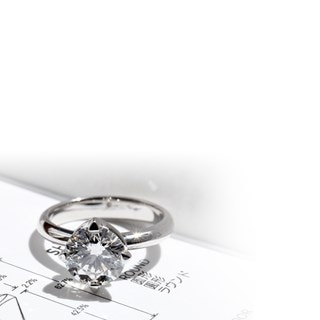
The Standard 4cs: Cut
Cut refers to the cutting and polishing of the diamond.
Cutting is one of the most crucial stages in determining the way the light reflects and refracts within the diamond, creating brilliance, fire and scintillation to the naked eye. Brilliance is the white light reflected from the internal and external surfaces of the diamond. Fire―or ”dispersion”―means the flashes of color that come from the diamond. Scintillation is the sparkle or flashes of light you see as the diamond moves.
The cut of a diamond can also affect its visual size. Two diamonds with the same carat weight can appear to be different sizes depending on the depth or shape of their cut.
The three main factors that influence the light performance of the diamond are its polish, symmetry and proportions.
Polish: Poorly polished facets and damaged surfaces do not reflect light or scintillate well.
Symmetry: Misalignment in facet dimensions and angles diminishes a diamond’s internal light performance or refraction, reducing the dispersion and brilliance.
Proportions: The proportion of the diamond’s crown and pavilion to the diamond. A well-proportioned diamond will reflect light within itself, from one facet to another. If a diamond is cut too deep or too shallow, light will be lost through the side or bottom, which reduces its brilliance and value. A well-cut diamond provides a balance between brilliance, fire and scintillation.
There are only universally agreed Proportions criteria for round diamonds, not for fancy shape diamonds. As a result, only round diamonds can receive a Cut grade, which covers the Polish, Symmetry and Proportions.
Fancy shape diamonds can be evaluated on their Polish and Symmetry, but not on their Proportions; therefore, fancy shape diamonds cannot receive a Cut grade. However, the Forevermark Diamond Institute has determined its own minimum and maximum Proportions parameters for fancy shape diamonds (note, fancy shape diamonds over two carats and in fancy colors are assessed separately because of their rarity).
When evaluating diamonds, Forevermark assesses all the elements of the cut: Polish, Symmetry and Proportions. Only round diamonds with a Cut grade of Very Good or Excellent and fancy shape diamonds that meet our criteria for beauty are eligible. Even those diamonds that satisfy our cut criteria must still fulfill our other quality criteria to become Forevermark.
This ensures that only diamonds that exhibit outstanding beauty can become Forevermark.
Forevermark diamonds are available in a variety of fancy shapes. The properties of the rough diamond will often have a hand in determining what shape the polished diamond will become. The most familiar diamond shapes are round, princess, oval, square, marquise, pear, radiant, emerald and cushion.





